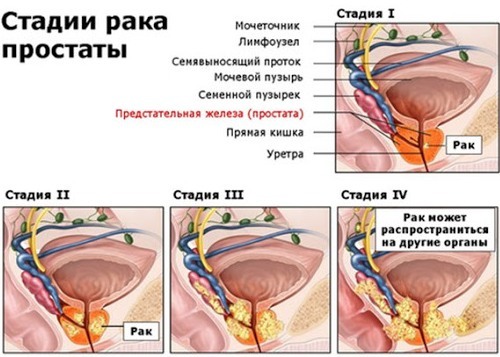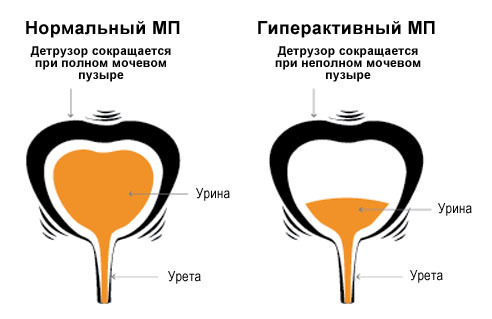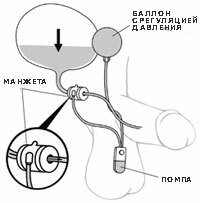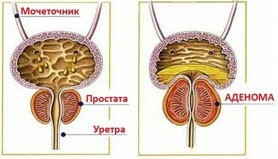Stadiality of prostate cancer: stages of the disease development and prognosis
According to medical statistics, oncological lesions of the prostate gland are on the "honorable" third place among all types of cancer. Every eighth man on the planet is ill. Unfortunately, in recent years, the disease has become a tendency to a sharp rejuvenation: if only the elderly had suffered before, it is unlikely that the oncologist will be surprised to find advanced prostate cancer in a stronger-sex representative 35-40 years of age. This is an extremely aggressive form of the neoplastic process. Nevertheless, in the early stages it is quite successfully treated. The prognosis, clinical picture and method of therapy depend on the stage of tumor formation.

Malignant neoplasm of prostate( prostate cancer)
The four-stage classification of prostate cancer is universally recognized.
Contents
- 1 Stage I
- 1.1 What is characterized?
- 1.2 How is it manifested?
- 1.3 Forecast
- 1.4 Tactics of treatment
- 2 Stage II
- 2.1 What is characteristic of?
- 2.2 How is it manifested?
- 2.3 Forecast
- 2.4 Treatment of
- 3 Stage III
- 3.1 What is characterized by?
- 3.2 How is it manifested?
- 3.3 Forecast
- 3.4 Therapeutic tactics
- 4 Stage IV
- 4.1 What is characterized?
- 4.2 How is it manifested?
- 4.3 Forecast
- 4.4 Treatment
Stage I
What is characteristic?
At this stage, the cancerous tumor is just being formed in the structure of the epithelial tissues of the gland. As a rule, carcinoma is formed from the glandular cells of the organ. Neoplasm does not go beyond the prostate and does not cause compression of surrounding tissues. Depending on the histological structure of the tumor, this stage is divided into two types. I-1 stage is characterized by good cell differentiation. Atypia is expressed to a minimal extent. For the I-2 stage, the development of cells with a lesser degree of differentiation is typical, but the cytological units are still recognizable.
How is it manifested?
Since the dimensions of volumetric formation at this stage are small( 1.2-3 cm in diameter), symptomatology, as a rule, is absent. When localizing near the urethral canal, undeveloped manifestations of the urinary tract are possible: slight weakening of the urine stream, pulling pains when emptying the bladder, burning and rubbing. However, as a rule, this stage remains unnoticed.
Forecast
The most favorable. The value of 5-year survival is 99-100%, 10-year survival is about 97-98%.Just need to make a reservation.5-year survival does not mean that the patient will live a maximum of 5 years. This is just a specialized medical term, reflecting the term of disease-free disease( that is, the likelihood that the disease will not return within the specified period).At the end of this time the patient is considered conditionally recovered.
Tactics of treatment
Since it is not known how the tumor will behave later, the most frequent observation is dynamic observation( diagnosis is performed monthly).At this stage preference is given to surgical intervention. Since there is no possibility to distinguish between healthy and diseased tissues, the entire prostate is removed. This is a radical but highly effective method. Since this is a traumatic operation, the doctor may resort to radiation therapy.

The four-stage classification of prostate cancer
is generally recognized. Stage II
What is characterized?
The tumor in the second stage differs in size. As a rule, we are talking about 3-5 cm in diameter. The doctor can easily palpate the neoplasm by means of a rectal finger examination. However, despite the considerable size, the oncological formation still does not go beyond the prostate gland. As the medical practice shows, the following variants of the development of prostate cancer of the 2nd stage are possible:
- The tumor is located in the thickness of the glandular cells, it has small dimensions, it is not palpable at all. However, the parameters of the prostatic specific antigen are outside the norm( which does not happen in the first stage of cancer of the gland).
- Neoplasm is localized in one lobe of the prostate gland and is well palpated, because it is large.
- Both lobes of the prostate are affected by small tumors.
Thus, options are possible. Tumors can be multiple.
How does it manifest itself?
Severe discomfort in the genital area, anus, lower abdomen. Erection and ejaculation are painful, in the structure of sperm and urine, blood admixtures are possible. There are problems with potency, but at this stage are insignificant. Urination becomes difficult: urine pressure weakens, there is an incomplete emptying of the bladder, there may be false urge to urinate( pollakiuria).However, at the second stage of the formation of oncopathology, the signs are still not specific enough to distinguish the cancer from prostate adenoma or prostatitis.
Forecast
Because the tumor is located within the gland, and there are no metastases - the prognosis is favorable.5-year survival is observed in 85-90% of cases, 10-year survival - in 80-85%.This is a good indicator, considering that prostate cancer is very aggressive.
Treatment of
In the second stage there is no question of wait-and-see tactics. It is necessary to remove the prostate gland. Practically minimally invasive transurethral techniques are used. If for any reason the operation can not be performed, a course of radiation therapy is shown.
Stage III
What is characterized?
Yes, this stage is already possible variants of tumor development. In any case, the formation sprouts the walls of the prostate gland and affects nearby anatomical structures: seminal vesicles or the urethral canal. It is a question of large tumors more than 7 cm in diameter. Mature cancerous prostate can give metastases. Depending on whether secondary damage is present atypical cells or not, two variants of of the third stage are isolated:
- III-A stage. A tumor of large size, blocks the lumen of the urethra, it can germinate into seminal vesicles. However, there are no metastases.
- III-B stage. A tumor of any size gives metastases to the regional lymph nodes( usually inguinal).
How is it manifested?
All the previously described symptoms become many times brighter. The outflow of urine from the bladder is violated, the volume of residual urine reaches 50-150 ml, possibly the development of acute delay. All symptoms are caused by compression of the urethra by a large formation. However, this is not always the case. The clinical picture can remain poor until the final stage of the neoplastic process develops, since even in the third stage the tumor can be small.
Forecast
Depends on the specific form of cancer in the third stage. If metastases are absent, 5-year survival is observed in 65-70% of cases. In the presence of a metastatic process, we are talking about a conditionally unfavorable prognosis, since survival rate is sharply reduced to 40-50% at best.
Therapeutic tactics
Surgical intervention is shown. With a large tumor size( over 8 cm) - an open cavity operation. Before the intervention, in order to stabilize the size of the tumor, it is necessary to conduct radiation and chemotherapy. Also excision of regional lymph nodes affected by the oncogenic process is necessary.
Stage IV
What is characterized?
This is the final stage of development of the tumor process. More often it is a question of neoplasms of considerable size, more than 8-10 cm in diameter. Atypia of cells reaches a peak: differentiation is minimal or absent, it is impossible to determine from what tissues cytological units occur. The new growth sprouts the tissues of the prostate gland, affects the urethral canal, the bladder, and the intestines also suffer from especially large tumors. Neoplasm gives metastasis to distant organs and systems. On the lymphogenous and hematogenous path, atypical cells settle in the lungs, the brain, and the liver.
How is it manifested?
In addition to focal symptoms that are characteristic of previous stages, general manifestations are noted:
- Headache.
- Sharp weight loss.
- Hyperthermia( 37.5-38 degrees).
Cases of acute urinary retention are common. Full impotence is coming. Perhaps the edema of the external genitalia.
In the future, distant focal symptomatology is observed on the part of structures affected by metastases.
Forecast
Unfavorable.5-year survival rate barely reaches 10-20%, provided complex therapy is provided.
Treatment of
It is impossible to heal cancer at such a neglected stage. It is only about palliative measures to maintain a minimum quality of life. There are performed: surgery, chemotherapy, radiation therapy, removal of secondary metastases, performing other operations to normalize the excretory function of the body. Anesthetics are prescribed.
Read more: Nutrition for prostate cancer of different degrees
Recommended viewing:



